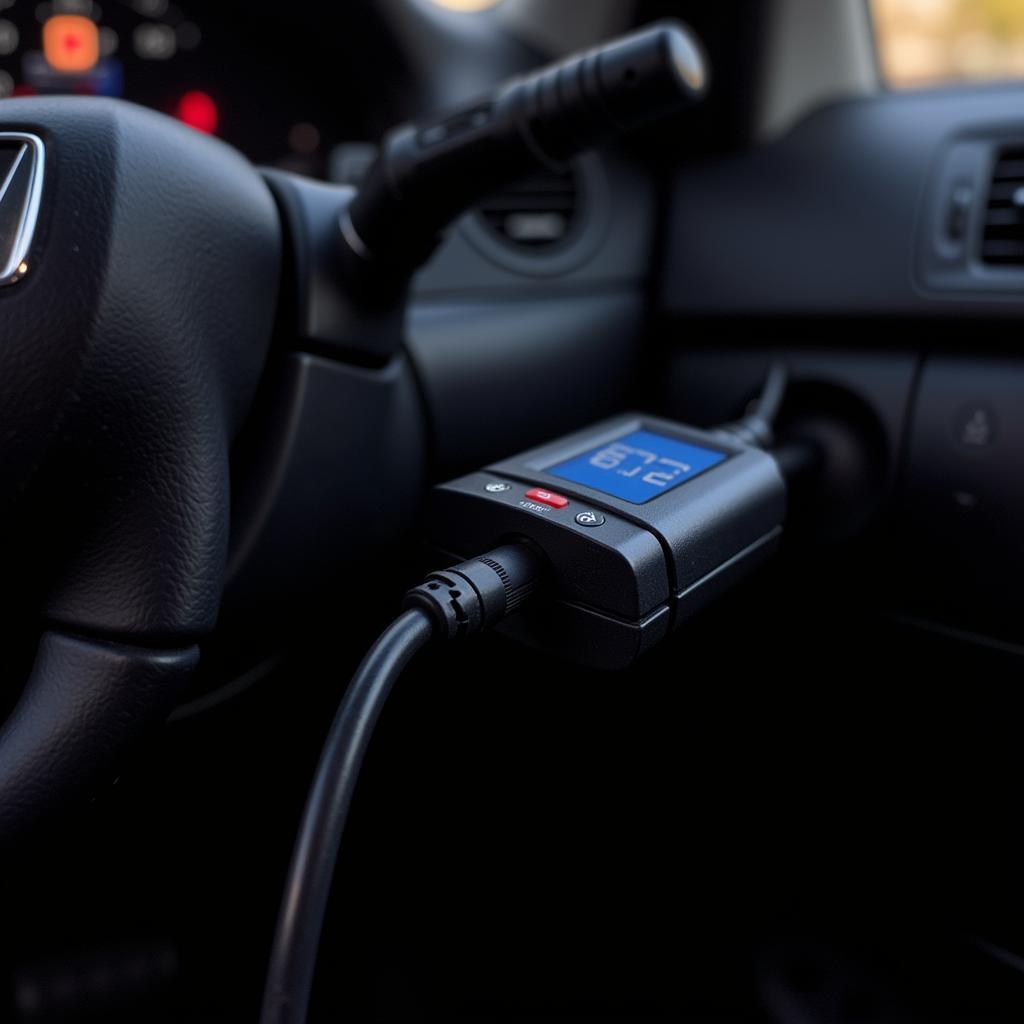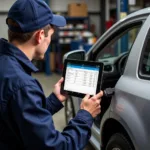A flashing check engine light can be stressful, especially when you rely on your Honda for daily commutes or weekend adventures. Fortunately, understanding your car’s onboard diagnostic system (OBD2) codes can help demystify those cryptic warnings and empower you to address potential issues. This comprehensive guide delves into the world of Honda OBD2 codes, providing you with the knowledge to decipher your car’s signals and take appropriate action.
What are Honda OBD2 Codes?
Imagine your Honda’s engine as a complex orchestra, with each component playing a crucial role in creating a harmonious symphony of power and efficiency. Now, picture the OBD2 system as the conductor, constantly monitoring each instrument for the slightest discord. When something goes awry, the OBD2 system generates specific codes, akin to musical notes, indicating the location and nature of the problem.
These codes, displayed as a combination of letters and numbers, act as a diagnostic language, allowing mechanics and car enthusiasts alike to pinpoint the root cause of automotive ailments. Understanding these codes can be incredibly valuable, whether you’re a DIY mechanic or prefer to communicate effectively with a trusted professional.
Deciphering Honda OBD2 Codes: A Breakdown
Honda OBD2 codes follow a standardized format, consisting of a single letter followed by four digits. This structure allows for a systematic categorization of issues, making it easier to navigate the vast library of potential problems.
-
The First Letter: This letter indicates the system where the fault originates:
- P: Powertrain (engine, transmission, emissions)
- B: Body (airbags, power windows, central locking)
- C: Chassis (ABS, traction control, suspension)
- U: Network & Communication (modules, wiring, sensors)
-
The First Digit: This number further narrows down the problem area:
- 0: Standardized code used across all car manufacturers
- 1: Manufacturer-specific code unique to Honda
-
The Remaining Three Digits: These numbers specify the particular problem within the identified system.
For example, a code like “P0302” indicates a powertrain (P) issue, utilizing a standardized code (0), related to a cylinder 2 misfire (302).
 Honda OBD2 Scanner in a car
Honda OBD2 Scanner in a car
Common Honda OBD2 Codes and Their Meanings
While the sheer number of potential OBD2 codes can seem daunting, a handful of codes appear frequently in Hondas, signaling common issues.
Engine-Related Codes:
- P0171/P0174: These codes indicate a lean air-fuel mixture, meaning the engine is receiving too much air or not enough fuel. Potential causes include a faulty oxygen sensor, mass airflow sensor, or vacuum leak.
- P0300 – P0306: This range of codes signifies a cylinder misfire, a common problem caused by faulty spark plugs, ignition coils, or fuel injectors. A misfire can result in engine hesitation, rough idling, or reduced power.
- P0420/P0430: These codes suggest a catalytic converter problem, often due to a failing oxygen sensor or a rich air-fuel mixture. A faulty catalytic converter can hinder engine performance and increase emissions.
Transmission-Related Codes:
- P0700: This code acts as a general transmission control system warning, indicating a potential issue with the transmission control module (TCM), solenoids, or wiring.
- P0730 – P0770: This range of codes points to problems within the transmission’s gear ratios or shift solenoids, potentially leading to slipping, harsh shifting, or a complete inability to shift gears.
Emissions-Related Codes:
- P0440 – P0446: These codes often signal an issue with the evaporative emissions control (EVAP) system, responsible for capturing fuel vapors from the fuel tank. A loose gas cap, faulty purge valve, or damaged EVAP canister can trigger these codes.
- P0135/P0141: These codes indicate a problem with the oxygen sensor heater circuit, essential for ensuring the sensor reaches its optimal operating temperature quickly.
How to Read Honda OBD2 Codes
Reading your Honda’s OBD2 codes no longer requires a trip to the mechanic. Affordable OBD2 scanners, readily available online and at auto parts stores, empower car owners to diagnose issues independently.
Here’s a step-by-step guide to retrieving those codes:
- Locate the OBD2 Port: Typically located under the driver’s side dashboard near the steering column, the OBD2 port resembles a trapezoid with a 16-pin connector.
- Connect the OBD2 Scanner: Turn the ignition to the “on” position (without starting the engine) and connect the scanner to the port.
- Retrieve the Codes: Most scanners will automatically establish communication with the vehicle’s computer. Navigate the scanner’s menu to read or retrieve stored codes.
- Record the Codes: Jot down the exact alphanumeric codes displayed on the scanner. These codes will be your roadmap for further research and diagnosis.
Pro Tip: Many OBD2 scanners also offer additional features like viewing live data streams, freeze frame data (a snapshot of engine parameters at the time a fault occurred), and the ability to clear codes after addressing the underlying issue.
What to Do After Retrieving Honda OBD2 Codes
Once armed with the knowledge of your Honda’s OBD2 codes, you have several options:
- DIY Repair: If you’re mechanically inclined and confident in your abilities, use the codes as a starting point for further research. Online forums, repair manuals, and YouTube tutorials can provide invaluable insights and step-by-step guidance for tackling common issues.
- Consult a Trusted Mechanic: For more complex problems or if you prefer professional assistance, provide your mechanic with the retrieved codes. This will expedite the diagnostic process and ensure they focus on the relevant systems, potentially saving you time and money.
- Utilize Online Resources: Numerous websites specialize in decoding OBD2 codes, offering detailed explanations, potential causes, and common solutions. Reputable sources like OBDFree provide a wealth of information to help you understand and address your Honda’s specific needs.
Honda OBD2 Codes: Beyond Diagnostics
Understanding your Honda’s OBD2 codes offers several advantages beyond simple troubleshooting:
- Preventative Maintenance: Regularly scanning for codes, even before the check engine light illuminates, can help identify developing issues early on. Addressing these problems proactively can prevent more costly repairs down the line and extend the lifespan of your vehicle.
- Informed Decision-Making: Whether you’re purchasing a used Honda or evaluating the overall health of your current car, knowledge of OBD2 codes can be invaluable. Checking for stored codes during a pre-purchase inspection can reveal potential red flags or hidden problems, empowering you to make an informed decision.
- Enhanced Communication: Communicating effectively with your mechanic is crucial for a smooth and efficient repair experience. Knowing the specific codes related to your Honda’s symptoms allows you to convey the issue accurately, fostering trust and understanding with your chosen professional.
FAQs: Your Honda OBD2 Questions Answered
Q1: Can I drive my Honda with a check engine light on?
While it’s technically possible to drive with the check engine light illuminated, it’s generally not advisable. Ignoring the warning could potentially exacerbate the underlying issue, leading to more significant and costly repairs in the future.
Q2: Will disconnecting the battery reset Honda OBD2 codes?
Yes, disconnecting the battery for a short period can temporarily clear stored codes and extinguish the check engine light. However, this is not a permanent solution. If the underlying problem persists, the codes will reappear once the vehicle’s computer completes its diagnostic cycle.
Q3: Are all Honda OBD2 scanners created equal?
OBD2 scanners vary in features, functionality, and price. Basic scanners will retrieve and clear codes, while more advanced models offer live data, freeze frame data, and manufacturer-specific capabilities. Choose a scanner that aligns with your needs and budget.
Q4: Can I get oil pressure information from the OBD2 connector?
While the OBD2 port provides access to a wealth of data, oil pressure is not typically included. Some vehicles may offer this information through manufacturer-specific parameters, but it’s not a standard feature across all models.
Q5: Can I convert my Honda from OBD2 to OBD1?
While it is technically possible to convert a Honda from OBD2 to OBD1, it’s generally not recommended. OBD2 offers more comprehensive diagnostics and emissions monitoring, making it a more robust and environmentally friendly system.
Conclusion
Mastering the language of Honda OBD2 codes empowers you to take control of your car’s health. From deciphering those cryptic warnings to communicating effectively with mechanics and making informed repair decisions, understanding these codes can save you time, money, and potential headaches down the road.
For further information on specific Honda models, troubleshooting tips, and detailed code explanations, explore the wealth of resources available on OBDFree. Our commitment to providing accurate, up-to-date, and easy-to-understand information empowers you to navigate the world of automotive diagnostics with confidence.
Remember, a deeper understanding of your Honda begins with deciphering its OBD2 codes. Embrace the power of knowledge and unlock a smoother, more enjoyable driving experience.
For immediate assistance with your Honda’s OBD2 codes, contact our expert team via WhatsApp at +1(641)206-8880 or email us at [email protected]. Our 24/7 customer support is always here to help you get back on the road with peace of mind.

